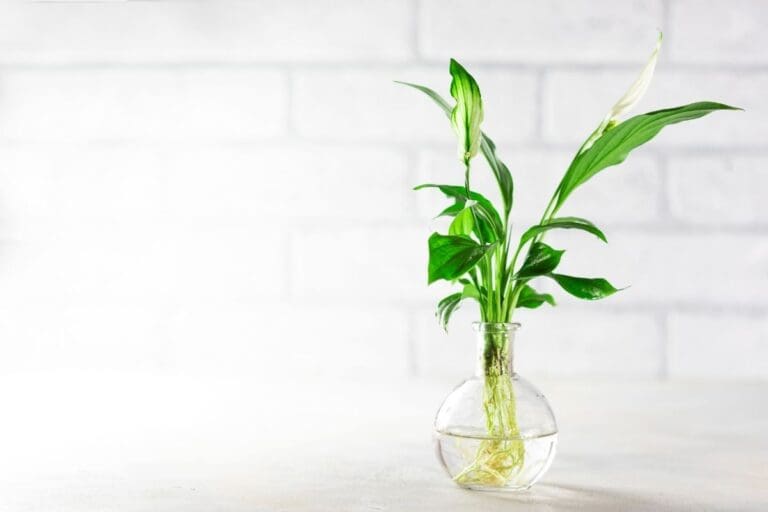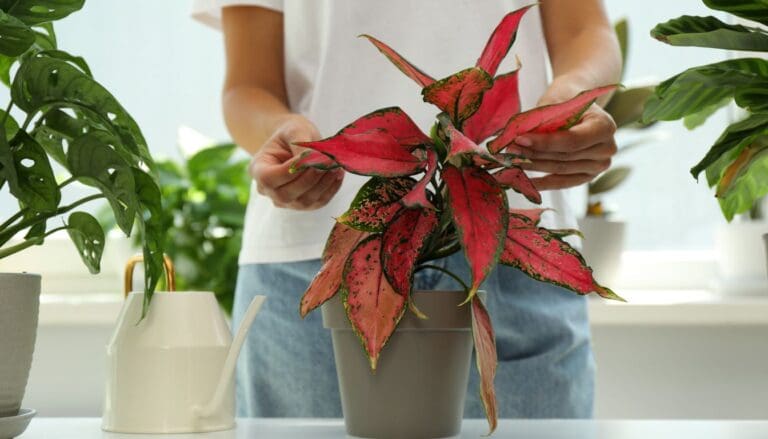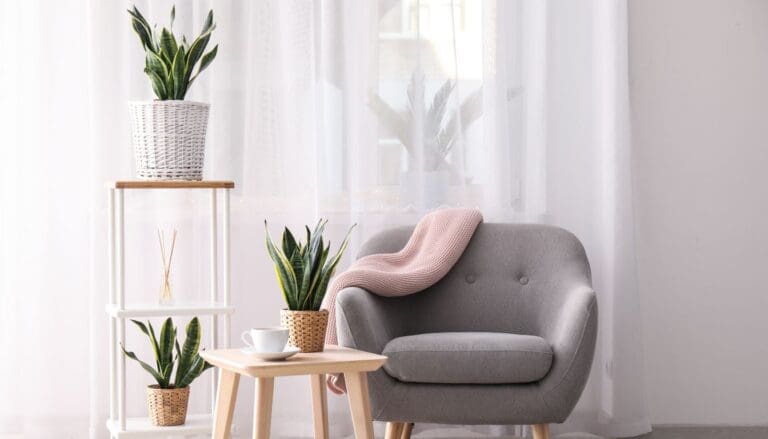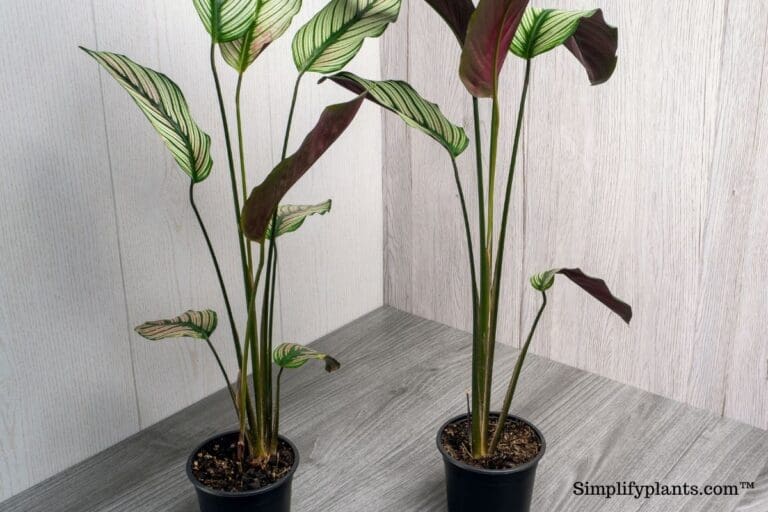Why Is My Calathea Dying? (Possible Problems & Signs)
Calatheas are popular houseplants due to their stunning foliage. But, when it comes to taking care of them, Calatheas can be a little dramatic. Slight changes or negligence can lead to wilting of the plant.
Now, your Calathea might be dying due to several reasons. And in this article, we shall discuss why is your calathea dying and how can you save them.
The most common reasons for a dying calathea plant are underwatering and overwatering. While underwatering causes the leaves to droop and wilt, overwatering leads to root rot, which kills the calathea plant. Other reasons are exposure to direct sunlight, overfertilization, and pest infestation.
To save a dying Calathea, you must provide bright indirect sunlight, check the soil’s moisture with a moisture meter, and water when needed. Try to maintain at least 50% humidity and temperatures between 65°F-80°F. Also, spray neem oil solution to keep pests and fungal diseases away.
If you start providing the proper remedies to cure your Calathea, you can cure damages and diseases in the initial stage. Let’s discuss the causes that can lead to the death of your Calathea and its remedies.

Please note: Simplify Plants is reader-supported. Some links in the post are affiliate links and I get a commission from purchases made through links in the post.
Signs that show Calathea is dying
Calatheas show signs of damage when neglected. You should be smart enough to identify the initial signs your plant is showing you.
Recognizing the early signs of damage can help recover the plant to a great extent. Inspect your plant regularly, look for any unusual signs, color, or leaf structure.
The signs which can help you to identify that your Calathea is unhealthy are:
- Lower leaves turning yellow
- Tips of the leaves turning brown
- Curling leaves
- Foul-smelling soil
- Wilted foliage
- Soggy soil
- Sunburned leaves
- Stunted growth
These signs can indicate your Calathea is dying and needs immediate attention. In the points below, we have briefly explained the remedies and preventions.
How to save a dying Calathea?
Seeing the death of your favorite Calathea in front of your eyes is disheartening. No one wants to lose their beautiful Calathea and watch it die.
So, the first step to recover your plant is to identify the exact reason it is dying. Several reasons can make your Calathea unhealthy, but inadequate watering practice is the most common one.
If your plant is in its early stage of damage, recovering it will be easy and fast. Prolonged damage and negligence will kill your Calathea.
For your ease, we have mentioned the remedies and prevention to every cause that might destroy your lovely Calathea.
Overwatering

We all can agree that Calathea is a moisture-loving plant. But that doesn’t mean one should water their plant frequently.
Frequently watering your Calathea with or one that has a poor drainage facility is dangerous.
Overwatering decreases or even cuts off the supply of oxygen to the roots. Roots depend on oxygen to function correctly. Insufficient oxygen level is a threat to its survival.
Moreover, overwatering can lead to root rot. Excess water in the soil will cause waterlogging, which will restrict the airflow between the roots. This condition will suffocate your plant.
Symptoms:
The signs of overwatering are:
- The lower epidermis of the leave turns yellow
- Wilted or floppy leaves
- New leaves turn yellow or brown before maturing.
- Leaves falling
- the stinking smell from the soil
- Pest infestation
Remedies to follow:
- Stop watering your Calathea until it recovers.
- Place the plant in a place where the soil can get dry. Expose it to bright indirect sunlight and a ventilated place.
- Prune the leaves that are already damaged. It will help your Calathea focus on the growth of new leaves.
- Take the Calathea out of its pot and check for any signs of root rot.
- If you can detect root rot, carefully report it in a pot bigger than the previous one with freshly mixed soil.
Preventions:
- Calatheas prefer weekly watering, so always water once a week.
- Use your fingers or moisture meter to check the moisture level of the soil.
- If the top 2 layers feel dry, then you can water your thirsty Calathea. Ensure that 2/4th of the soil is dry before you water it, or it will make the soil soggy.
- Choose the suitable soil with good moisture-holding capacity.
- In case the pot you are using is small or has poor drainage, change it. Wrong soil for your plant will take time to dry.
- Never make a watering schedule and follow it blindly. Check the moisture in your soil regularly to ensure the smooth functioning of the planet.
Also read: How To Fix Overwatered Calathea? (Possible Cause, Signs & How To Fix)
Underwatering

Calatheas enjoy moisture. Underwatering your Calathea plant causes dehydration.
Sometimes Calathea owners forget to water their plants. Calatheas can withstand a lack of water for a few days. But if it persists for long, the plant’s health starts deteriorating.
Recovering an underwatered Calathea is easier than an overwatered one.
Symptoms:
- Curled leaves
- Brown leaves with crisp edges
- Weak stem and leaves
- Soil dry and cracking
- Stunted growth
- Wilted plant
Remedies:
- Prune the damaged leaves as they will not turn healthy again. So, it’s better to get rid of them.
- Thoroughly water your plant till you notice moist soil and water running out from the drainage holes.
- Use a water spray and mist the plant. This will help to restore moisture and humidity.
- You can use the bottom watering method.
- Take a tray, fill it half with water and place the pot on it. Water will pass through the drainage hole and supply enough water to your dry Calathea plant.
Prevention:
After your plant’s recovery, here are some measures that will prevent dehydration the next time.
- Water your plant correctly. Calathea likes its soil to be moist.
- You can set the alarm or schedule to avoid forgetting water sessions. The schedule should be appropriate for your plant, and overwatering can also cause several issues.
- During winters, it is okay to water your plant once every two weeks because of the season. But during summer, when the weather is hot and dry, you should water your plant properly to avoid dehydration.
- Calatheas need proper watering during their growing seasons. So, keep that in consideration.
Also read: How Often To Water Calathea? (A Complete Calathea Watering Guide)
Exposure to direct sunlight

Due to their low sunlight tolerance, Calatheas are considered houseplants or indoor plants. In their natural habitat, Calathea grows under the shade of large trees, where they receive dappled sunlight.
Calatheas cannot tolerate direct sunlight. Even a little exposure to the sunlight for a few minutes can cause sunburn.
Symptoms:
Large white patches on the leaves are the first thing you will notice on your plant.
- Decrease in the rate of growth
- Brown leaves with crisp edges
- Pale leaves, as if the leaves are bleached
- Discoloration on the upper part of the leaves
Remedies:
Fixing a sunburned Calathea is not that tough if a cure is started at an early stage of damage.
- The most necessary step is to change the spot of your Calathea to an area where it will receive less or no direct sunlight.
- Trim the damaged leaves to allow the plant to invest its energy in the new growth.
- Thoroughly water the dry plant to make it moist again.
Prevention:
- The first step is to take the plant and keep it in a place where it will not get direct sunlight.
- If you have kept your Calathea outdoor, immediately bring it inside a room and prevent it from receiving direct sunlight.
- Never keep your Calathea outdoors like – outer balcony, outside the main door, and places where there is a chance of getting direct sunlight.
- Direct sunlight will cause sunburn and also sometimes the death of your dear plant.
Also read: Is My Calathea Getting Too Much Sun? (Sunburnt Calathea)
Temperature fluctuations

Calathea is a tropical plant native to Central and Southern America as well as Africa. They prefer warm, humid areas with high temperatures.
Fluctuating temperature can shock the plant because it is hard for the plant to adjust and carry out its normal functions due to frequent fluctuations.
Symptoms:
- Wilted leaves
- Yellow leaves
- Leaves turning curly
- Droopy leaves
- Brown patches on the leaf surface
Remedies:
- By now, you might have understood that pruning the affected leaves is a must. So, prune the damaged leaves and release the burden from your plant’s shoulders.
- Do not keep your plant under direct sunlight. The excessive heat from sunlight will absorb the natural moisture from the leaves and further dehydrate them.
- During winters, keep your plant in a warmer place. The outside temperature can be too cold and unbearable for your plant.
- You should maintain an equilibrium of temperature.
Prevention:
- The ideal temperature for Calathea is 65- 80° F, so try to maintain that.
- Temperature above 85°F is too hot for your plant. Try to avoid that.
- You can keep your plant near the fireplace, furnace, or heater during winters, but not too close. This will protect the plant from low temperatures.
- To protect your Calathea, keep it away from the direct contact of air conditioners and heaters. As they have an unstable temperature and wind control, it might severely affect the plant.
Also read: What Temperature Can Calathea Tolerate? (Ideal Temperature Range)
Low Humidity

Calatheas love humidity. They flourish and become more lustrous when they get the required amount of moisture and humidity.
A humidity level above 50% helps them to grow. But if the humidity levels fall during winter, the plant develops different problems.
Many symptoms can tell you that your Calathea is getting less humidity.
Symptoms:
- Wilted leaves
- Dry leaves
- The tips of the leaves turn brown
Remedies:
- Maintain a humidity level above 50% in the surrounding atmosphere of your Calathea.
- You can use a spray bottle and mist around your plant to increase humidity.
- Keep your plant in a place where it can get sufficient humidity, such as the bathroom.
- Install a humidifier to control the humidity level. A humidifier can increase the humidity level in a room, and it is readily available in online and offline shops.
Prevention:
- Never place your Calathea under direct sunlight, as it can reduce the humidity by making the plant dry.
- Try to maintain a higher humidity level using a humidifier, misting, or keeping it with other humidity-loving plants.
- Ensure that the soil is not dry and you are providing proper watering.
- Use the bottom watering tray method to ensure a continuous supply of moisture. But, be careful to avoid overwatering.
Also read: Should I Mist My Calathea Plant? (Calathea Humidity Requirements)
Excessive use of fertilizers

In our indoors, the supply of nutrients is limited to the quantity of soil. Plants only get nutrition from the limited soil in the pot.
Fertilization helps to fill the lack of nutrition from the soil. It provides the plant with ample nutrition during the growth phase.
Overfertilization is dangerous for your Calathea as it can burn the roots and kill the plant.
Symptoms:
- Brown leaves with crisp edges
- Weak leaves and stem.
- Salt deposit on the soil surface
- Yellow and wilted leaves from the lower end of the plant
- Decrease in the rate of growth
Remedies:
- Trim the leaves that are damaged.
- Repot the plant after changing the overfertilized soil.
- Use a fresh soil mix to repot the plant.
- Check the roots of the plant, detangle them and rinse them with water. This process will help to wash out the excess fertilizer.
Prevention:
- Use fertilizers with an NPK (Nitrogen: phosphorus: potassium) ratio of 10:10:10.
- Before using fertilizers, make sure that you are pretty knowledgeable about the method of fertilization and the type of fertilizer to use.
- Lastly, never use too much fertilizer on your Calathea. They don’t need much fertilization.
Also read: Should I Fertilize Calathea? (How Often+Best Fertilizer)
Final words
Being a Calathea owner, you have immense love for your plant. You have invested your time, affection, care, and energy to grow the plant. Thus, seeing your plant dying is heartbreaking.
Calathea can be finicky, but if you understand its requirements and care for it accordingly, you’ll be able to save it from the problems that can cause its death.
Proper watering is essential to maintain the health of Calathea. Always try to maintain a temperature between 65-80°F and it should be stable to avoid stressing the plant. Keep your Calathea away from direct sunlight as they need indirect light.
Lastly, I have mentioned all the possible reasons for a dying Calathea in the article. I hope it helps you identify the exact reason and cure it accordingly.
Source: NCBI, University of Florida, Wikipedia, Growing Indoor Plants with Success, Agriculture, and Natural Resources, University of California, Missouri Botanical Garden.
Recommended Garden Supplies
| Product Image | Our Recommended Gardening Supplies | Check Offers! |
|---|---|---|
Top Top
Top
Top
Top
Top
Top
Top
Top | rePotme Houseplant and Tropical Classic Potting Soil Mix | Check Offer On Amazon |
 Top
Top
Top
Top
Top
Top
Top
Top | Espoma Organic Indoor Plant Food | Check Offer On Amazon |
 Top
Top
Top
Top
Top
Top
Top
Top | GooingTop LED Grow Light 6000K Full Spectrum Clip Plant Growing Lamp | Check Offer On Amazon |
 Top
Top
Top
Top
Top
Top
Top
Top | Soil Moisture Meter | Check Offer On Amazon |
 Top
Top
Top
Top
Top
Top
Top
Top | Govee Hygrometer Thermometer, Bluetooth Enabled! | Check Offer On Amazon |
 Top
Top | LEVOIT Humidifiers for Large Room(Best For Plants) | Check Offer On Amazon |
 Top
Top
Top
Top
Top
Top
Top
Top | Upgraded DIY Automatic Drip Irrigation Kit, 15 Potted Houseplants Support | Check Offer On Amazon |
 Top
Top
Top
Top
Top
Top
Top
Top | Stainless Steel Heavy Duty Gardening Tool Set | Check Offer On Amazon |
 Top
Top
Top
Top
Top
Top
Top
Top | Bonide Insecticidal Soap | Check Offer On Amazon |
 Top
Top
Top
Top
Top
Top
Top
Top | Bonide 32 oz Spray Neem Oil for Organic Gardening | Check Offer On Amazon |
 Top
Top
Top
Top
Top
Top
Top
Top | Garden Safe Fungicide | Check Offer On Amazon |






